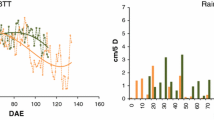Summary
A greenhouse study was conducted to determine the effects of soil temperature (10.0. 12.8, 15.6, 17.2, 17.8, 19.4, and 21.1 C), soil compaction (1.00, 1.15, and 1.20 g/cm3), and nitrogen fertilization (0, 60, 120, and 240 lbs/acre-ft) on emergence and growth of Russet Burbank potatoes.
Both soil temperature and compaction affected emergence. At 12.8 C and a soil bulk density of 1.20, plant emergence was delayed as much as 2 weeks as compared with that at 21.1 C and a soil bulk density of 1.00. Following emergence the rate of elongation of the delayed plants was accelerated sufficiently that differences in plant height were not apparent at termination of the experiments. However, vigor and growth were greatly impaired.
Nitrogen fertilizer enhanced top and root growth but tended to reduce the number of tubers per plant and their weight, especially at the higher rates. Also, at the lower temperatures and higher bulk densities nitrogen tended to delay plant emergence.
Apparently, mechanical impedance to roots because of soil compaction had a modifying effect on root development, which in turn restricted plant growth.
Resumen
Se llevó a cabo un estudio de invernadero para determinar el efecto de la temperature del suelo (10.0, 12.8, 15.6, 17.2, 17.8, 19.4 y 21.1 °C), compactación del suelo (1.00, 1.15 y 1.20 g/cm3) y abonamiento con nitrógeno (0, 60, 120, y 240 libras acre-piés) sobre el brote y crecimiento de papas Russet Burbank.
Tanto la temperatura como la compactación del suelo influenciaron el brote. A la temperatura de 12.8° C y densidad sel suelo de 1.20, el mrote de plantas se retrasó hasta 2 semanas en comparación con el brote a la temperatura de 21.1 ° C y densidad de suelo de 1.00. Después del brote la tasa de elongation de las plantas retrasadas se aceleró de tal manera que no se pudo observar diferencia alguna en la altura de las plantas al terminar el experimento.
El abono de nitrógeno promovió el crecimiento de las matas y de las raices pero tendió a reducir el número de tubérculos por planta y también su peso, especialmente cuando la proportión de nitrógeno era muy alta. También, cuando las temperaturas eran más bajas y la densidad del suelo era más alta, el nitrógeno tendia a retardar el brote de las plantas.
Similar content being viewed by others
Literature Cited
Baver, L. D. 1956. Soil physics, p. 199, 203. 3rd ed. John Wiley and Sons, New York.
Bennett, W. H. Root and miscellaneous crops. Mimeo., Dept. of Agronomy, Utah State Univ., Logan, Utah.
Blake, G. R., D. H. Boelter, E. P. Adams and J. K. Aase. 1960. Soil compaction and potato growth. Amer. Potato J. 37: 409–413.
Bradley, George A. and Arthur J. Pratt. 1955. The effects of different combinations of soil moisture and nitrogen levels on early plant development and tuber set of the potato. Amer. Potato J. 32: 254–258.
Bushneil, John. 1956. Exploratory study of the rate of oxygen consumption by potato roots. Amer. Potato J. 33: 203–210.
Bushnell, John. 1956. Growth responses from restricting the oxygen at roots of young potato plants. Amer. Potato J. 33: 242–248.
Hardenburg, E. V. 1949. Potato production, p. 22–23, 39. Comstock Publishing Co., Inc., New York.
Meyer, Bernard S., Donald B. Anderson and Richard H. Böhning. 1960. Introduction to plant physiology, p. 429–430. D. Van Nostrand Co., Inc., Princeton, N. J.
Sommerfeldt, Theron G. and K. W. Knutson. 1965. Effects of nitrogen and phosphorus on the growth and development of Russet Burbank potatoes grown in southeastern Idaho. Amer. Potato J. 42: 351–360.
Sommerfeldt, Theron G. and Kenneth W. Knutson. 1968. Effects of soil conditions in the field on growth of Russet Burbank potatoes in southeastern Idaho. Amer. Potato J. 45: 238–246.
Struchtemeyer, R. A., E. Epstein and W. J. Grant. 1963. Some effects of irrigation and soil compaction on potatoes. Amer. Potato J. 40: 266–270.
Author information
Authors and Affiliations
Additional information
Contribution from the Department of Agricultural Biochemistry and Soils and the Department of Plant Science, Agricultural Experiment Station, University of Idaho, Aberdeen, Idaho, and approved as Research Paper No. 736.
Rights and permissions
About this article
Cite this article
Sommerfeldt, T.G., Knutson, K.W. Greenhouse study of early potato growth response to soil temperature, bulk density and nitrogen fertilizer. American Potato Journal 45, 231–237 (1968). https://doi.org/10.1007/BF02849915
Accepted:
Issue Date:
DOI: https://doi.org/10.1007/BF02849915




